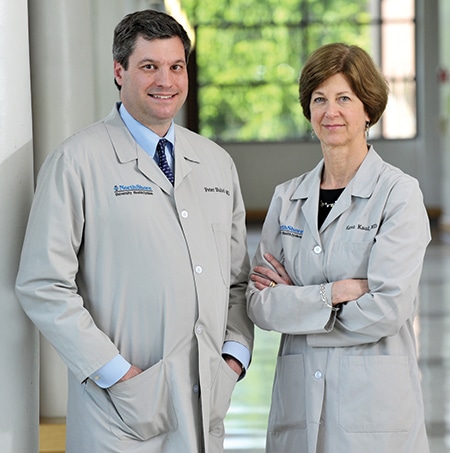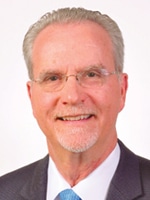Karen Titus
June 2019—It took David Ledbetter, PhD, a mere six years or so to become a hero.
Dr. Ledbetter, executive vice president and chief scientific officer, Geisinger, had helped oversee the expansion of the health system’s MyCode precision medicine project, which began as a traditional research biobank in 2007. Recent years brought giant steps: expanded enrollment (some 235,000 Geisinger patients have consented); a collaboration with Regeneron Pharmaceuticals, which had built a large DNA sequencing lab; exome sequencing of 145,000 Geisinger patients; publications in the New England Journal of Medicine, among other journals.

Dr. Peter Hulick and Dr. Karen Kaul at NorthShore University HealthSystem, which has expanded its genetic testing, most recently with free genetic screening. “This is happening,” Dr. Kaul says to labs. “We need to recognize there’s a lot going on outside our walls.” (Photo courtesy of Bruce Powell)
Tucked into all of this was a decision, in 2013, to do clinical laboratory confirmatory testing of American College of Medical Genetics and Genomics secondary findings, including those linked to hereditary breast and ovarian cancer syndrome, Lynch syndrome, and familial hypercholesterolemia. “Some would say it was a controversial decision,” Dr. Ledbetter recalls. Results would no longer be rolled away into research; Geisinger would be returning clinical genetics laboratory reports that would go to the patient’s medical record, the primary care physician, and the patient.
A sense of puzzlement ran even deeper. For those first five or six years, when Dr. Ledbetter encountered clinicians—primary care physicians and specialists alike—on campus, grand rounds, etc., “They would come up to me and say, ‘David, can you explain to me one more time why we do research at Geisinger? We’re not a university, we’re not an academic medical center in the traditional sense. I came here to take care of patients. Why are we doing research in Danville, Pa.?’”
Dr. Ledbetter says he met those questions head-on, patiently explaining, again and again, how he thought this would be clinically beneficial in the not-too-distant future, how it might help them, in some cases, prevent the onset of cancer, cardiovascular events, and the like.
As happens with many earnest, thoughtful responses, “My patient explanations had pretty close to zero impact,” Dr. Ledbetter recalls.
That is, until recently, when MyCode results entered the clinical realm. “The first time a primary care doc gets a BRCA1 result on one of their patients, it’s transformative,” Dr. Ledbetter says.
And by helping his colleagues use genetic test results to practice advanced medicine, “I’ve become a hero,” he says.
Heroics aside, population genetics screening appears to be on the verge of transforming medicine in ways yet to be imagined.Genetics testing seems to be chugging along on an Overland Route of sorts, as the traditional clinical approach (patient-by-patient, gene-by-gene, disease-by-disease) meets with whole exome or genome sequencing of patients without obvious disease or family history. Unlike with the First Transcontinental Railroad, however, no one is aiming for a triumphant, final handshake in Utah.
“I don’t know where this will end up,” says Karen Kaul, MD, PhD, chair, Department of Pathology and Laboratory Medicine, NorthShore University HealthSystem, Evanston, Ill. As her own institution sets up several genetic testing projects that emphasize population screening rather than diagnostics, she and others find themselves searching but confident, the way a yogi might encourage students to simply keep returning to the mat, unattached to a particular outcome. “But I am sure we will learn from our population screening program, called DNA-10K, and all of these genomic projects. Doing the work and having this information will shape the way care is delivered for years to come.”
Amy Sturm, MS, LGC, co-director, MyCode Genomic Screening and Counseling, and professor, Genomic Medicine Institute, offers one example of what this might look like, based on a recent case at Geisinger.
A woman who was concerned about her family history of cancer initially went through Geisinger’s clinical genetics testing pathway; her family didn’t meet set criteria for a cancer condition, and it was recommended that cancer genetic testing start with an affected relative.
The relative did not pursue testing. “But sure enough, this same woman had enrolled in MyCode, and we ended up finding a variant for Lynch syndrome,” Sturm says. The woman had a total abdominal hysterectomy preventively, and was found to have a very early stage endometrial carcinoma.
It’s not that the clinical pathway failed, Sturm says, because everything was done right. “But it shows you the difference between the typical clinical genetic testing pathway compared to the population genomics screening approach, where you do have the capability to find more people with variants,” says Sturm, who is also director of cardiovascular genomic counseling, Geisinger, and president, National Society of Genetic Counselors.
As institutions collect and harnessvast amounts of genetic data, they are also trying to figure out what patients and clinicians want to do with test results.Peter Hulick, MD, medical director, Mark R. Neaman Center for Personalized Medicine, and division head, Center for Medical Genetics, calls NorthShore’s current genomics projects a naturally evolving area of interest. Over the past five or six years, he says, patients have become more cognizant of genetics and begun asking for testing. That was one reason NorthShore established its Center for Personalized Medicine, which in turn broke down many of the traditional barriers across division and department lines, he says.
The first major project was NorthShore’s Genomic Health Initiative, a research project aimed at developing a cohort of 100,000 enrollees, whose genomic information will also be tied to their electronic health record.
“What we found is that the patients—excuse me, subjects; they’re patients in our systems but subjects in the study—had the option to consent to return of results,” Dr. Hulick says. “Well over 90 percent wanted this information.”
His terminology slip-up is telling, illustrative of the converging worlds of research and clinical care. What happens when subjects become patients, when research data and previously esoteric test results become part of routine clinical care?
At NorthShore, that meant flinging open the door to let primary care physicians disseminate genetic information. “We had extensive training of our primary care docs,” says Dr. Kaul, including in the use of a screening/family history tool that allows for more structured genetic testing and directing patients to one of NorthShore’s personalized medicine programs. “We need to make this a standard part of care and educate our clinical colleagues, because nobody’s really, even now, learning this in medical school. It’s changing medicine, and for us to understand how to do that responsibly and effectively, we need to work across the medical system.”
NorthShore has gone down traditional education paths, including grand rounds, webinars, and after-dinner events, Dr. Hulick reports. When they rolled out the pharmacogenomics program, they tried a see-one, do-one, teach-one approach, in which interested primary care physicians went through the testing process themselves and learned their results to get a sense of what their patients might experience. There were also educational pre-visits—for medical assistants and nurses as well as physicians—before a site went live; when a site launched, Dr. Hulick or a colleague was on hand to provide support.
“The challenge is, especially in the primary care physician world, they’re very busy clinicians, and some you can only give a sound bite of information,” Dr. Hulick says. That’s where the screening/family history tool comes in. If there’s an indication for a test, a best-practice alert is activated during the patient’s annual history and physical. The alert includes an explanation and gives primary care providers prepopulated order sets that either refer the patient to a NorthShore specialty clinic or order the genetic testing.
“Are best-practice alerts the end-all, be-all solution? No,” says Dr. Hulick. “But it helps move the needle. I think that’s what’s key with our initiatives. We haven’t solved everything. But we can implement, and then we try to make it better.” Besides, he adds, “If you wait for ‘the perfect solution,’ you’re never going to implement anything. And each time we’ve implemented something, we’ve learned valuable information.” The final goal, he says, is to make genetic testing available to anyone who needs it or simply wants it.
The EHR is key, Dr. Hulick says. “We often talk about solving the last mile to delivery of personalized medicine or getting genomics-based care.” In a statement that might give labs pause, he continues, “So many people feel like that’s just getting the lab test completed. But that’s just the first quarter mile.” Population genetics screening is just as much about tracking data in the system as reporting a result. “If you just have a scanned-in PDF of someone’s genetic test result, it’s very hard to do anything with that in the EMR.” And remember, says Dr. Hulick, “No EMR came out of the box ready to handle genomic information.”
The ideal EHR sounds like an Aston Martin, responsive to every new turn. At NorthShore, for example, “There’s been a major effort with our urology colleagues to raise awareness with BRCA2 in particular for prostate cancer risk,” says Dr. Hulick. Having those results in the EMR in a structured format could help push educational materials to patients in addition to doctors, updating them on what to do with the information. Prescribing physicians also have pharmacogenomic information (this testing is done in-house), with a clinical decision support alert system baked into the EMR, says Dr. Hulick.
All of these system-level approaches tie back to the educational piece, Dr. Hulick notes. “The goal with the EMR is to give enough information at the time of care, so that a clinician who is not an expert in genomics will have enough understanding to use that information effectively.”

Dr. Ledbetter
As Dr. Ledbetter learned on his hero’s journey, case-based learning is indeed an effective way to reach and teach clinicians. “When it’s their own patient, it’s much more effective,” he says. “It’s altered a lot of our thinking about how to provide genetics information and support. It really needs to be point-of-care or just-in-time information.”
Well before results began landing in EHRs, however, came the decision to start chipping away at the Berlin Wall that has long separated research endeavors from clinical care, even when the former includes laboratory data that might be clinically important.Geisinger’s MyCode team knew they’d be uncovering mutations like BRCA1 and BRCA2. “We were uncomfortable knowing that we were going to generate data that could be beneficial to our patients’ health,” Dr. Ledbetter says. That led to numerous focus groups, where patients expressed interest in receiving genetic data relevant to their health and that of their children and grandchildren.
Since Geisinger began returning such results, some 1,000 patients have been found to have a clear disease-causing genomic variant. They’ve been offered genetic counseling. Those whose variants are related to cancer are referred for imaging. “We’ve identified a number of early-stage cancers presymptomatically that we think improves patient outcomes,” says Dr. Ledbetter.
 CAP TODAY Pathology/Laboratory Medicine/Laboratory Management
CAP TODAY Pathology/Laboratory Medicine/Laboratory Management
